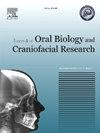“Comparison among 3 maxillomandibular fixation techniques for management of mandibular fractures – A prospective randomized study”
Q1 Medicine
Journal of oral biology and craniofacial research
Pub Date : 2025-07-07
DOI:10.1016/j.jobcr.2025.06.020
引用次数: 0
Abstract
Background
The Erich arch bar has been a traditional method for maxillomandibular fixation (MMF) in the closed management of mandibular fractures, but it presents significant disadvantages, including prolonged placement time, increased risk of operator injury, and compromised oral hygiene. To address these challenges, alternative methods such as IMF screws and hybrid arch bars have been introduced.
Purpose
This study aimed to compare the efficacy, advantages, disadvantages, and potential complications of three MMF techniques, IMF screws, hybrid arch bars, and Erich arch bars in the management of mandibular fractures.
Study design
This study follows the CONSORT guidelines for randomized clinical trials. A total of 45 patients with mandibular fractures were randomized into three equal groups: Group A (IMF screws), Group B (Hybrid arch bars), and Group C (Erich arch bars). Randomization was performed using a computer-generated sequence, with allocation concealment achieved through sealed opaque envelopes. Blinding was not feasible due to the nature of the interventions.
The primary outcome variables included occlusal assessment and fracture reduction. Secondary outcomes included the time required for placement and removal of MMF devices, postoperative pain (VAS score), and operator-related complications such as glove perforation.
Co-variates-Age, site of mandible fracture & multiple fracture of mandible.
Results
All 45 patients were included in the final analysis. Occlusion was successfully achieved in all patients except one (6.7 %) in the IMF screw group. The mean time for MMF placement and removal was highest in the Erich arch bar group, followed by the hybrid arch bar group, and was lowest in the IMF screw group (p < 0.001). Glove perforation occurred in 6 Erich arch bar group subjects during placement. The mean VAS pain score was highest in the Erich arch bar group at the time of placement, at 24 h, and at 1 week (p = 0.002, 0.004, and 0.018, respectively).
Conclusion
and Relevance: This study highlights that IMF screws offer a more efficient, safer, and less painful alternative for MMF compared to Erich and hybrid arch bars. Considering the shorter procedural time, reduced operator risk, and better patient comfort, IMF screws appear to be the preferred choice for the closed management of minimally to moderately displaced isolated mandibular fractures.
3种上颌下颌固定技术治疗下颌骨骨折的前瞻性随机研究
背景:Erich弓棒一直是下颌骨折闭合性治疗中传统的上颌骨下颌骨固定(MMF)方法,但它存在明显的缺点,包括放置时间延长、操作人员受伤风险增加和口腔卫生受损。为了应对这些挑战,引入了IMF螺钉和混合拱杆等替代方法。目的比较三种MMF技术、IMF螺钉、混合型弓棒和Erich弓棒治疗下颌骨骨折的疗效、优缺点和潜在并发症。本研究遵循CONSORT随机临床试验指南。将45例下颌骨骨折患者随机分为三组:A组(IMF螺钉)、B组(Hybrid弓棒)和C组(Erich弓棒)。随机化使用计算机生成的序列进行,分配隐藏通过密封的不透明信封实现。由于干预措施的性质,盲法是不可行的。主要结局变量包括咬合评估和骨折复位。次要结果包括放置和取出MMF装置所需的时间,术后疼痛(VAS评分)和手术相关并发症,如手套穿孔。协变量:年龄、下颌骨骨折部位;下颌骨多发骨折。结果45例患者均纳入最终分析。除IMF螺钉组1例(6.7%)外,其余患者均成功闭塞。MMF放置和取出的平均时间Erich弓棒组最高,其次是混合型弓棒组,IMF螺钉组最低(p <;0.001)。在放置过程中,有6例Erich弓棒组受试者出现手套穿孔。在放置时、24 h和1周时,Erich弓棒组VAS疼痛平均评分最高(p分别= 0.002、0.004和0.018)。结论和相关性:本研究强调,与Erich和混合弓棒相比,IMF螺钉为MMF提供了更有效、更安全、更少痛苦的替代方案。考虑到更短的手术时间、更低的手术风险和更好的患者舒适度,IMF螺钉似乎是微创至中度移位的孤立性下颌骨骨折闭合治疗的首选。
本文章由计算机程序翻译,如有差异,请以英文原文为准。
求助全文
约1分钟内获得全文
求助全文
来源期刊

Journal of oral biology and craniofacial research
Medicine-Otorhinolaryngology
CiteScore
4.90
自引率
0.00%
发文量
133
审稿时长
167 days
期刊介绍:
Journal of Oral Biology and Craniofacial Research (JOBCR)is the official journal of the Craniofacial Research Foundation (CRF). The journal aims to provide a common platform for both clinical and translational research and to promote interdisciplinary sciences in craniofacial region. JOBCR publishes content that includes diseases, injuries and defects in the head, neck, face, jaws and the hard and soft tissues of the mouth and jaws and face region; diagnosis and medical management of diseases specific to the orofacial tissues and of oral manifestations of systemic diseases; studies on identifying populations at risk of oral disease or in need of specific care, and comparing regional, environmental, social, and access similarities and differences in dental care between populations; diseases of the mouth and related structures like salivary glands, temporomandibular joints, facial muscles and perioral skin; biomedical engineering, tissue engineering and stem cells. The journal publishes reviews, commentaries, peer-reviewed original research articles, short communication, and case reports.
 求助内容:
求助内容: 应助结果提醒方式:
应助结果提醒方式:


